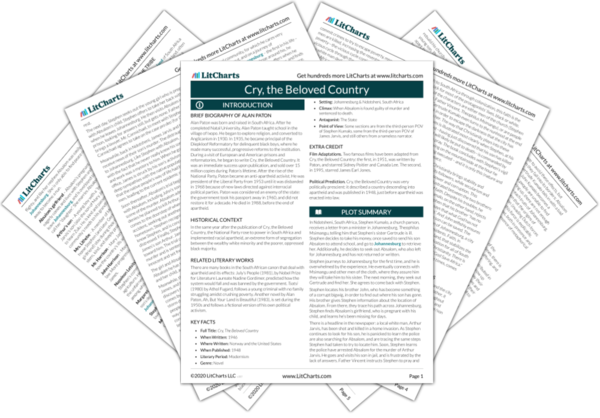The Land and the Tribe
In Cry, The Beloved Country, the land of South Africa and the original Zulu inhabitants of that land, often called "the tribe," depend upon each other, in a cycle of support and care. Without one, the other is broken, weakened, and dying. Many characters, including Gertrude and Absalom Kumalo, suffer greatly when they leave their village in the country for Johannesburg. The city brings death and corruption: its inhabitants, at worst, are…
read analysis of The Land and the TribeRacism and Apartheid
Cry, The Beloved Country takes place during the historical period of growing racial tension and strife that led to the political policy of apartheid in South Africa, a policy in which the ruling whites enforced a system of strict racial segregation. In the time when the book is set, this policy has not yet been officially enacted, but the novel shows how economic inequality along racial lines sows the seeds of resentment, mistrust, and fear…
read analysis of Racism and ApartheidThe City vs. Nature
The city of Johannesburg is portrayed as a place to which people are inevitably drawn, and from which they never return, regardless of race. What keeps them there varies from person to person – sometimes they are killed, or put in prison, or descend into poverty or crime – but the constant is that they never return to their homes or families. Arthur Jarvis leaves his father and goes into Johannesburg, but dies before he…
read analysis of The City vs. Nature
Christian Faith
Despite the fact that it was the white British and Dutch colonizers who introduced the Christian faith to South Africa through colonization, this faith is the bedrock for most of the protagonists’ lives, black or white. Many of the characters are either men of the church (Stephen Kumalo, Father Vincent, Theophilus Msimangu), or are people of faith. Gertrude Kumalo even turns to the nunhood at the end of the book in…
read analysis of Christian FaithFathers, Sons, and Families
When the land and tribe are corrupted, and the city and the country are pitted against one another, it follows that families will break apart. Throughout the novel, families are torn to pieces, particularly fathers and sons. In particular, the novel explores two significant father/son relationships: that of Stephen Kumalo and his son Absalom Kumalo, and that of James Jarvis, and his son Arthur Jarvis. Both sons vanish to Johannesburg, and their…
read analysis of Fathers, Sons, and FamiliesUnderstanding/Knowledge vs. Ignorance/Naiveté
The city of Johannesburg can turn the most learned men into metaphorical children. Its nuances require a new and different kind of understanding. Without that understanding, Stephen—the most knowledgeable man in his community—is robbed within minutes of arriving in the city. But knowledge has a special kind of power: you can pass it on to others. Stephen feels revived when he plays with Gertrude’s son. Stephen tells him stories about where he came…
read analysis of Understanding/Knowledge vs. Ignorance/Naiveté






